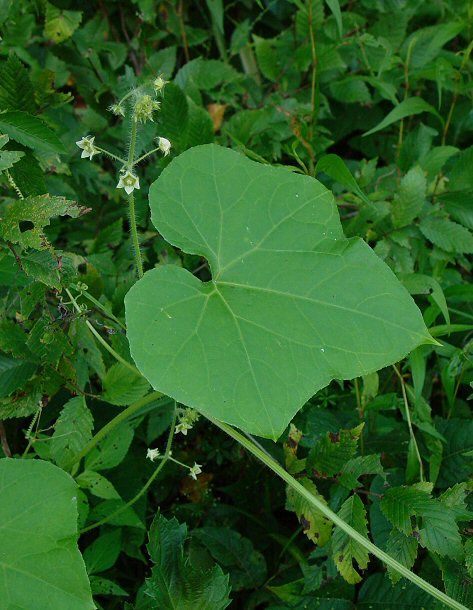Sicyos angulatus L.
Bur Cucumber

Native
CC = 4
CW = 0
MOC = 72
© DETenaglia
Sicyos angulatus L.Bur Cucumber | |
 |
Native CC = 4 CW = 0 MOC = 72 |
© DETenaglia |
|
Family - Cucurbitaceae Habit - Monoecious annual vine with slender taproot. Stems - Vining on other vegetation, to 5 m or more long, slender (1-2 mm in diameter), lacking glands at the tip, sparsely to moderately pubescent with slender, spreading, multicellular hairs, not roughened, at least some of the hairs usually minutely gland-tipped but the stems not strongly sticky, the tendrils branched.
Leaves - Alternate, simple, long-petiolate. Petioles 1-5 cm long, densely hairy. Leaf blades 2-20 cm long, 3-22 cm wide, broadly ovate to nearly circular in outline, palmately shallowly to moderately 5-lobed with usually 3 major lobes and 2 minor lobes, the lobes broadly triangular, with sharply pointed tips (those of the basalmost lobes occasionally rounded) and broadly rounded (more than 90°) sinuses, cordate at the base, the margins otherwise sparsely to moderately and finely toothed, the surfaces sparsely to densely pubescent with minute, nonsticky hairs, especially those of the upper surface often minutely pustular-based and thus somewhat roughened to the touch.
Inflorescence - Dense clusters (pistillate) or shrt racemes or clusters (staminate) in leaf axils, the main stalk of the pistillate inflorescence 10-40 mm long, the clustered flowers sessile or with individual stalks to 0.5 mm long.
Flowers - Calyx lobes 1.0-2.5 mm long. Corollas 8-12 mm wide, saucer-shaped to broadly bell-shaped, the 5 lobes 3-5 mm long, white to cream-colored with pale greenish nerves. Staminate flowers with the filaments fused into a tube, the anthers fused into a headlike mass. Pistillate flowers usually lacking staminodes, the ovary with 1 ovule, the stigma 3-lobed.
Fruits - Dry, modified berries in dense clusters, with the papery wall relatively closely enveloping the seed, indehiscent, 1.2-1.8 cm long, more or less ovoid or ellipsoid, somewhat flattened, with a stalk 15-60 mm long, the surface yellowish green to olive-colored, covered with slender, relatively stiff, straw-colored to pale yellow prickles 3-7 mm long, otherwise usually moderately pubescent with relatively long, fine, spreading, multicellular hairs. Seed 1, 7-10 mm long, 4-7 mm wide, elliptic-obovate to more or less elliptic in outline with a small pair of thickened basal areas, somewhat flattened, rounded to bluntly pointed at the tip, the surface otherwise relatively smooth, greenish brown to olive-colored.
Flowering - June - October. Habitat - Low woods, bottoms, base of bluffs, fields, thickets, railroads. Origin - Native to the U.S. Lookalikes - Distantly, Echinocystis lobata. Other info. - This annual vine is common in alluvial areas throughout most of Missouri and the eastern half of the continental U.S. It is an easy species to ID because of its big leaves, interesting flowers, and clusters of spiny fruits. The plant is monoecious, bearing both male (staminate) and female (pistillate) flowers. The staminate flowers are unusual in having the anthers fused into a headlike structure. The spines on the fruits are flexible when green, but when the fruit has matured they become rigid, and being very sharp can easily penetrate the skin. The stems and leaves of the plant resemble those of many other species in the family. Photographs taken along the shores of the Current River, Shannon County, MO., 9-5-03 and 9-20-03 (DETenaglia); also at Riverfront Park, Washington, Franklin County, MO, 8-23-2014, Onondaga Cave State Park, Crawford County, MO, 9-11-2017; and along the Katy Trail near Treloar, Warren County, MO, 9-2-2024 (SRTurner). |